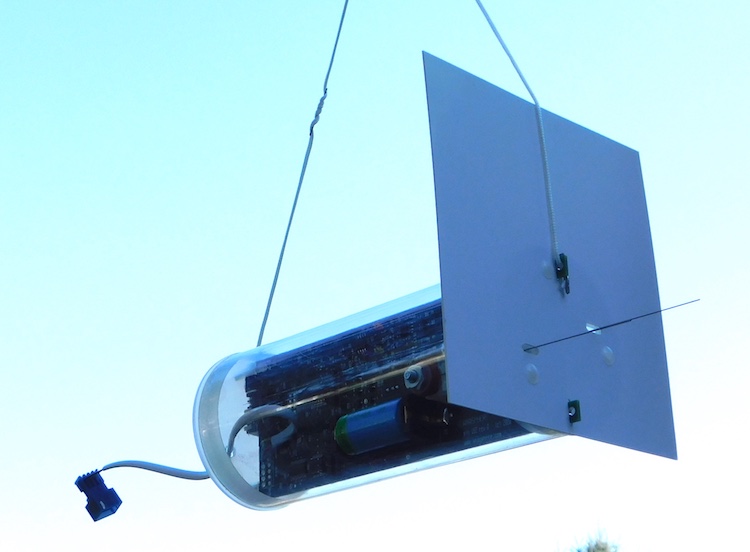
 The Universal Water Content (UWC) sensor is a device which can be used to measure all condensed phases of water in clouds: above-freezing liquid, supercooled liquid, and ice. The sensor operates using two wires: one is a bare wire for measuring supercooled liquid water content (SLWC), and the other is a gel-coated wire for measuring total water content (TWC). Combining these two water content measurements with temperature data (provided from a radiosonde) allows cloud water content to be measured and speciation to be determined.
Vibrating wire sensors such as these operate by measuring the buildup of water on a thin vibrating wire which is coated with a collection medium. The mass of collected water changes the vibration frequency of the wire. The rate of change of vibration frequency can be used to quantitatively determine the liquid water content of the cloud.
The second-generation UWC2 sensor is provided in three variants: the two-wire UWC2 sensor which measures all species, a supercooled liquid water content (SLWC) version which only has the bare wire for supercooled liquid measurements, and a total water content (TWC) version which only has the gel-coated wire for total water content measurements.
We can still offer the older SLWC sensor for users who prefer that variant.
The sensor is primarily intended to be flown on sounding balloons and used at such velocities (3-5 m/s). Other configurations of the sensor are possible for surface-based, extended operation, and UAV applications; please contact us for details.
The Universal Water Content (UWC) sensor is a device which can be used to measure all condensed phases of water in clouds: above-freezing liquid, supercooled liquid, and ice. The sensor operates using two wires: one is a bare wire for measuring supercooled liquid water content (SLWC), and the other is a gel-coated wire for measuring total water content (TWC). Combining these two water content measurements with temperature data (provided from a radiosonde) allows cloud water content to be measured and speciation to be determined.
Vibrating wire sensors such as these operate by measuring the buildup of water on a thin vibrating wire which is coated with a collection medium. The mass of collected water changes the vibration frequency of the wire. The rate of change of vibration frequency can be used to quantitatively determine the liquid water content of the cloud.
The second-generation UWC2 sensor is provided in three variants: the two-wire UWC2 sensor which measures all species, a supercooled liquid water content (SLWC) version which only has the bare wire for supercooled liquid measurements, and a total water content (TWC) version which only has the gel-coated wire for total water content measurements.
We can still offer the older SLWC sensor for users who prefer that variant.
The sensor is primarily intended to be flown on sounding balloons and used at such velocities (3-5 m/s). Other configurations of the sensor are possible for surface-based, extended operation, and UAV applications; please contact us for details.
Data Reporting
The UWC2 sensor is designed to pair with any radiosonde capable of accepting the XDATA digital data format.
Quantitative Measurements
The rate of change of vibration frequency (df/dt) is one part of the water content calculation. Additional information which must be known or estimated includes the rise rate of the balloon (or airspeed of the platform) and the median volume diameter (MVD) of the cloud droplets. Complete data reduction procedures and equations are given on our Cloud Sensor Resources page.
©2023 Anasphere, Inc.


